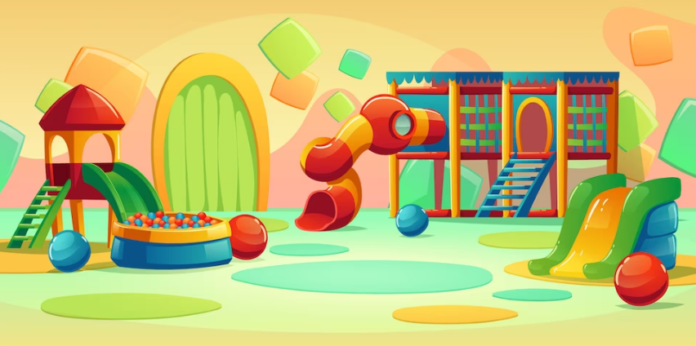A well-designed KIDS PLAY AREA is more than just a space for kids to run around; it’s a sanctuary for exploration, creativity, and growth. Whether it’s in your backyard, a community park, or a daycare center, designing a play area requires thoughtful consideration of safety, accessibility, and entertainment value. In this guide, we’ll explore the essential elements and practical tips for creating an engaging and safe play area for kids that sparks joy and fosters development in children.
Important things to remember for play area for Kids
Assessing Space and Safety
Prioritize safety concerns and evaluate the available area before launching into design concepts. Make sure there are no trip hazards, poisonous plants, or jagged edges in the play area. To reduce the possibility of accidents, build safety elements including age-appropriate equipment, protective fencing, safety cushions and soft ground coverings. Set clear limits to keep kids from straying off.
Designing Age-Appropriate Zones
Consider the age range of the children who will be using the play area and design distinct zones tailored to their developmental needs. For younger children, incorporate sensory-rich elements such as sandboxes, water tables, and tactile play surfaces. Older children may enjoy climbing structures, swings, slides, and balance beams that promote physical activity and coordination.
Stimulating Imagination with Creative Play
Incorporate things that stimulate creativity and storytelling to foster creative play. Construct a playhouse or fort so that kids may play pretend and role-play. Use accessories like costumes, pretend kitchens, and musical instruments as props to help them play together and develop young imaginations as well as their social skills. This will boost the imagination power of the kids.
Incorporating Natural Elements
Integrate nature into the play area by incorporating natural elements such as plants, trees, and natural materials like wood and stone. Create a sensory garden with fragrant herbs, colorful flowers, and textured plants to engage children’s senses and promote environmental awareness. Incorporate natural play features like tree stumps for climbing, logs for balancing, and boulders for hopping to provide opportunities for exploration and connection with the outdoors.
Providing Comfortable Seating and Shaded Areas
Provide cosy places for caregivers to sit so they can keep an eye on the kids and engage with them as they play. Provide covered spaces with picnic tables, benches, and other furnishings so that families may unwind and spend quality time together. To protect against the heat and provide a cool space for outdoor play even on hot days, think about adding pergolas, umbrellas, or naturally occurring shade structures.
Ensuring Accessibility for All
Design the play area with accessibility in mind to ensure that children of all abilities can fully participate in play. Incorporate wheelchair-accessible pathways, ramps, and play equipment designed for children with mobility challenges. Provide sensory-friendly features such as quiet retreat spaces and inclusive play equipment that accommodate children with sensory sensitivities or developmental differences.
Maintenance and Regular Inspections
To guarantee the play area’s lifespan and safety, routine upkeep and inspections are crucial. Regularly inspect the equipment for damage, loose bolts, and signs of wear and tear. Take quick action to fix any problems that you find. To make the play area a secure and welcoming space for kids to enjoy, keep it tidy and well-maintained and remove dangers, trash, and garbage on a regular basis.
Conclusion
Designing a play area for children is a rewarding endeavor that requires careful planning, creativity, and a commitment to safety and inclusivity. By incorporating age-appropriate elements, promoting imaginative play, integrating natural features, and ensuring accessibility, you can create a stimulating and safe environment where children can explore, learn, and thrive. So, roll up your sleeves, unleash your creativity, and embark on the journey of creating a magical play space that will delight and inspire children for years to come.


